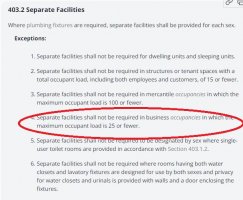SanAntoniArch
REGISTERED
Long time lurker, first time poster.
I have a Reviewer requiring two water closets per 403.1 for 17 occupants in a B occupancy. It's a chiropractors office.
I'm befuddled because I've never had anyone push for a second RR under 25 occupants. When I read Row No. 2 for B Occupancies, the box outlining the required number of Water Closets is shared across both Sexes, to me inferring that there's no requirement to separate the calculation.
It's always possible this Reviewer is interpreting correctly and all the others before had not, but I find it odd. Have done several TI's where the solution was a single unisex RR and only required to go up to two when it was serving an occupant load of 25+.
Am I on crazy pills? AHJ is on 2015 ICC's.
I have a Reviewer requiring two water closets per 403.1 for 17 occupants in a B occupancy. It's a chiropractors office.
I'm befuddled because I've never had anyone push for a second RR under 25 occupants. When I read Row No. 2 for B Occupancies, the box outlining the required number of Water Closets is shared across both Sexes, to me inferring that there's no requirement to separate the calculation.
It's always possible this Reviewer is interpreting correctly and all the others before had not, but I find it odd. Have done several TI's where the solution was a single unisex RR and only required to go up to two when it was serving an occupant load of 25+.
Am I on crazy pills? AHJ is on 2015 ICC's.






